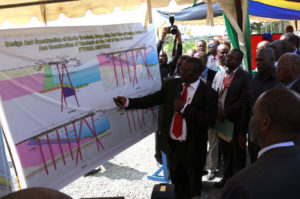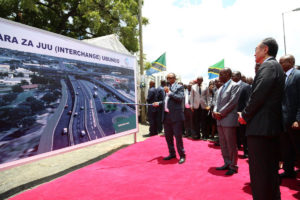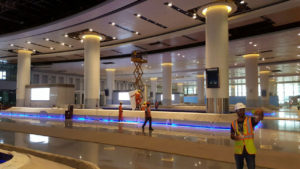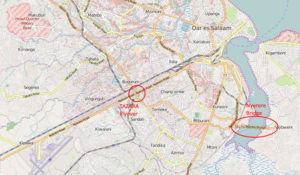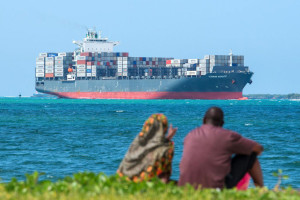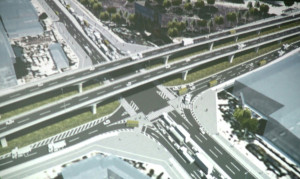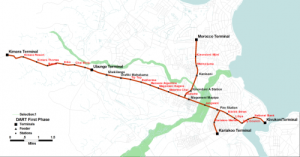by Ben Taylor
Arguments flare over Air Tanzania plane seized in Canada A new commercial aircraft, purchased by the government as part of President Magufuli’s efforts to boost the previously-ailing Air Tanzania (ATCL), has been seized in Canada by a construction firm in dispute with the Tanzanian government over a long-standing debt. The aircraft – a Bombardier Q400 – had been expected to arrive in Tanzania in July 2017, but remains in Canada at the time of writing. The Canadian firm, Stirling Civil Engineering Ltd, seized the plane in Canada over a $38 million lawsuit before it could be delivered by Bombardier Inc to the Tanzanian government. The claim stems from a 2010 compensation ruling by the International Court of Arbitration over a terminated contract to construct a road between Bagamoyo and Wazo Hill / Kunduchi.
The government plans to revive ATCL involve the purchase of at least six new aircraft, including one Boeing 787 Dreamliner. The new planes are reported to have been placed under the ownership of the Tanzania Government Flight Agency – a state-owned firm – to avoid possible confiscation of the planes from lawsuits related to Air Tanzania’s multi million-dollar debts from previous suppliers.
The seizure of the aircraft came to light after two opposition MPs, Zitto Kabwe (ACT Wazalendo) and Tundu Lissu (Chadema), asked questions about the late arrival of the new plane. Kabwe raised the matter on social media and then Lissu held a press conference. In response, the then acting director of Information Department
Services, Ms Zamaradi Kawawa, described the “Bombardier fiasco” as “dirty games” by some members of the opposition. “The government is aware that some of the opposition leaders are behind this. They hold malicious intentions towards efforts done by President Magufuli on bringing development in the country, but their days are numbered, their betrayal is intolerable,” she said, accusing them of being unpatriotic.
Lissu asked “who is patriotic between me and the government that didn’t want to tell its people about the court case and subsequent seizure of the plane? Who is sullying the image of the country internationally between me and the government which is failing to adhere to international standards and clear the debt since 2010?”
A few days later, Lissu was arrested and his residence in Dar es Salaam was searched by the police. Two weeks later, in early September, he was shot multiple times by unknown assailants outside his home in Dodoma. He narrowly survived the attack. (See politics section, this issue).
The government of Tanzania has appealed through diplomatic channels to the government of Canada to intervene to ensure the plane’s release and delivery to Tanzania. Further, the government has promised to challenge Stirling Civil Engineering’s claims in court. (The Citizen, Reuters)
Former ATCL chiefs found guilty
Two former senior officials of the same national airline (ATCL) have been found guilty of conspiracy, abuse of office and occasioning loss. Former Managing Director David Mattaka and his Chief Finance Officer Elisaph Ikombe were each sentenced to 21 years imprisonment or fines of TShs 35m each. They are expected to pay the fines. The trial magistrate, Victoria Nongwa, also gave the two convicts a one-month ultimatum to compensate ATCL with 143,442 US dollars (over TShs 320m), representing the loss they had caused.
The court found that while discharging their duties in 2007, the two intentionally abused their positions by inviting tenders to supply ATCL with 26 motor vehicles without approval of tender board, by procuring the motor vehicles from a Dubai-based firm without conducting competitive tendering, and by authorising payments for purchase of the motor vehicles without a formal procurement contract.
Tanzania purchases new radar equipment
The Tanzania Civil Aviation Authority (TCAA), has signed a TShs 61 billion contract with the French firm Thales Air Systems to install a new surveillance radar system. The system will involve installation of new equipment at four airports: Julius Nyerere International Airport (Dar es Salaam), Kilimanjaro International Airport, Songwe Airport in Mbeya and Mwanza Airport.
The Minister of Works, Transport and Communication, Prof Makame Mbarawa, spoke at the signing ceremony, explaining that a shortage of the relevant equipment in Tanzania has meant the eastern triangle portion of the country’s airspace is currently being monitored by Kenya. He noted that this has been denying TCAA up to $1m in fees annually from airlines using that portion of the airspace.
TCAA director general Hamza Johari said the project was part of wider efforts to secure the country’s air space. He added that TCAA would purchase the radars with internally sourced funds, of which 45% would be from the authority’s various sources and the government will provide the remaining 55%. He explained that the French firm won the tender through competitive bidding which involved five bidders.
New railway law
The Tanzanian Parliament has passed a new law – the Railways Act, 2017 – which will, among other things, enable the establishment of a new railway company, the Tanzania Railway Cooperation (TRC). The new company will be responsible for handling all rail matters including transportation services, developing, promoting and managing infrastructure assets in the country. The new law also facilitates the disbandment of Tanzania Railways Limited (TRL) and the Rail Assets Holding Company (RAHCO). “All the contracts and agreements entered by TRL and RAHCO will be accommodated into the new company that means even the debts that the two entities had,” said Minister of Works, Transport and Communication, Prof Mbarawa. He added that the new law will replace the 2002 Railways Act.
Bulldozer goes to work around Ubungo
President Magufuli has directed that the Tanesco headquarters building on Morogoro Road in Ubungo, Dar es Salaam must be demolished as it encroaches on the road reserve. The 10-story building is located within 90m of the centre of the road, in contravention of the Road Reserve Act. On the other side of the road, a boundary wall for the offices of the Ministry of Water also encroaches, and has already been demolished following the President’s instruction.
Potential demolition of the Tanesco building was raised in 2011 while President Magufuli was Ministry of Works. He had then instructed the National Roads Agency (Tanroads) and Tanesco to demolish the building, only to find himself overruled by the then Prime Minister, Mizengo Pinda.
Demolition of the building has become more urgent as the space is required for construction of a new $88m flyover interchange at Ubungo, similar to the interchange already under construction at TAZARA. Around 1,300 houses, public buildings and houses of prayers have been demolished this year by Tanroads to pave the way for the expansion of the Kimara-Kiluvya section of Morogoro Road.


